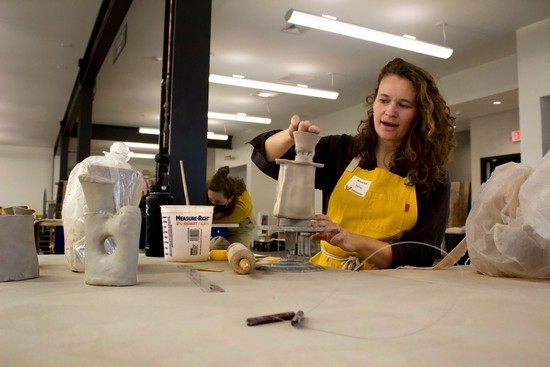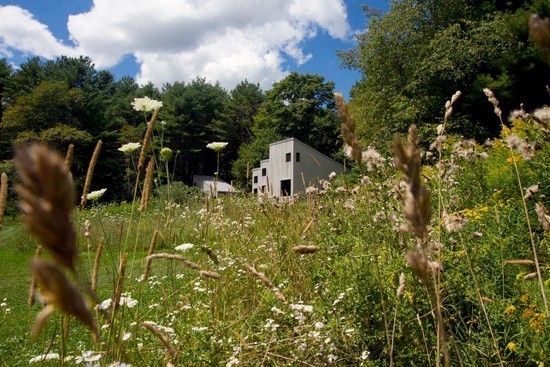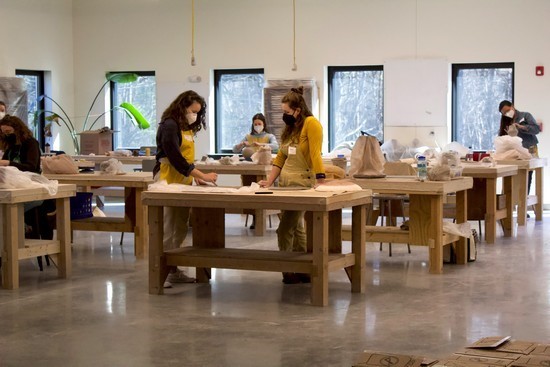The challenge: Make 10 small clay objects in
18 minutes — one minute each for the first five pieces, two minutes for the
next four and five for the last one.
اضافة اعلان
Ariela Kuh, a ceramic artist with a bright
demeanor and a yellow apron, set a timer on her iPhone as she explained the
drill to the 14 of us attending her workshop in April at the Watershed Center
for Ceramic Arts in Newcastle, Maine.
“Remember what it was like to touch clay as a
kid,” she advised.
As I prepared 10 tangerine-size balls of clay,
images from childhood flashed through my mind: the blue shelves at my
after-school pottery program, the bulbous terra-cotta vase my mom made at one
of the countless cancer facilities in the months before her death, the small
elephant at the center of a red ceramic plate that my tiny hands had formed
sometime in the mid-1990s and was now collecting dust.
“Go,” Kuh said, and there was no more time for
thinking. Clay shapes appeared and multiplied, each maintaining a vague
resemblance to the previous one, like snapshots of sea creatures undergoing
evolution, all shells and tentacles. By the time the final phone alarm blared,
I was giddy with the uninhibited joy you experience when letting go of
perfectionism.
Earth meets water
“Clay is the opposite of the cellphone,” said
D. Wayne Higby, an artist and the director of Ceramic Art Museum at Alfred
University in Alfred, New York. “This stuff is real, takes up space, it’s
dirty. There’s just this physicality that is very different from what we
experience six or eight hours a day sitting in front of a computer.”

This might partly explain pottery’s recent
resurgence in popularity.
Clay educators, artists, and industry experts
from across the United States told me of people flocking to pottery classes and
workshops, studios trying to get a handle on expanding waitlists, and ceramists
racking up huge online followings. (There is even a television show for
aficionados of the craft: “The Great Pottery Throw Down,” a production à la
“The Great British Baking Show,” streaming on Max.)
Shaping clay and bending time
“I like some organic wonkiness,” said Kuh as
she freehanded a rectangle out of a sheet of clay and seemingly effortlessly
curled the piece into a cylinder, then did the same with a circle, turning it
into a cone. “I’m not a rule follower. There’s a reason I didn’t become a
woodworker.”
The three-day class I was attending focused on
how to build geometric objects from slabs of clay and then use those to
assemble more intricate creations. Unlike wheel-throwing — where clay is molded
on a spinning disk — this technique, known as hand-building, can be used to
make a wide variety of forms and larger works.

As we broke into 25-pound bags of clay, the
room filled with the smell of damp soil and a studious silence, punctuated
occasionally by the sound of hands slapping and dropping the material to give
it the right texture.
A sign proclaimed the studio a no-cellphone
zone, and there were no clocks. As I bent, squeezed and smudged the gray dough
in my hands, a smooth and cool sensation spread from the tips of my fingers to
my head, pooling there, then drowning out anxieties and washing away my sense
of time. Shapes of clay morphed on the canvas-covered work tables, and
trapezoids of sun crept across the polished cement floors.
A medium that contains multitudes
Watershed is far from the only place in the
United States where potters can experience the fresh country air while
exploring the craft and its traditions.
Founded in 1929 to give Appalachian women a
means of earning a living, the Penland School of Craft in the Blue Ridge
Mountains of North Carolina — where clay was designated the “official state art
medium” in 2013 — draws artists and hobbyists with a range of programs in
different media. Summer clay workshops generally last between four and 12 days,
during which participants live on the 420-acre campus, and focus on a range of
functional and decorative aspects of pottery.

A three-hour drive east, the town of Seagrove,
which has one of the highest concentrations of working potters in the country,
advertises itself as America’s pottery capital.
The area is home to more than 50 pottery
shops, studios and galleries as well as the North Carolina Pottery Center, a
museum dedicated to the craft. Among its residents, Seagrove counts eighth- and
ninth-generation potters, as well as a growing number of young apprentices and
clay artists.
Tipping the scale from the utilitarian to the
artful has long been the mission of the Archie Bray Foundation for the Ceramic
Arts, in the foothills near Helena, Montana. Nearly three-quarters of a century
after the Bray was founded, the world appears ready for its contemporary take
on clay.
“Somewhere in the pandemic,” said the
foundation’s current director, Rebecca Harvey, “whatever that hierarchy was,
whatever that boundary between art and craft was, seems to have just
evaporated.” She pointed to the expanding number of artists, galleries and
museums — among them, the Metropolitan Museum of Art — that in recent years
have started to embrace clay work.
Pleasure over productivity
Kuh was trimming away the excess material from
a vessel reminiscent of an oversize dumpling, slowly imbuing it with the
delicacy of a curtain fluttering in the spring breeze.
It was the last day at the workshop, and she
was going over the finishing touches.
“Everyone has a different favorite part of the
process. I really love this refining part,” she said, shaving off ribbon after
ribbon of drying clay. “It’s like in writing, I like the editing part.”
Because of how long firing ceramics takes, we
would not be putting raw clay pieces, known as greenware, in the kiln, but
wrapping them to transport home.
Having flown to Maine and knowing this type of
clay would melt in the high-temperature kilns at my studio in New York, I
realized early on that my pieces would not be returning with me. The thought
was weirdly freeing.
Like many hobby ceramists, I had been drawn to
pottery because of the sense of purpose it gave me: making planters for my
friends, bowls for my family, a little cave for my fish, knickknacks for my
girlfriend.
I looked at the objects in front of me. One
resembled a muscular set of shoulders with a long and skinny neck; the other
reminded me of a volcanic hillside or tubular coral reef. What use would I
possibly have for them?
Maybe they could be vases or lamps. Or perhaps
their sole function was to bring me closer to the joy of playing I had so
rarely felt since childhood.
And why shouldn’t that be purpose enough, I
thought, as I dropped my creations into the reclaim bin, where scraps of clay
go to await their next adventure.
Read more Culture and Arts
Jordan News





